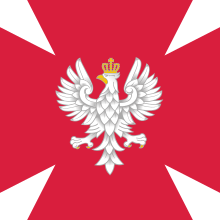
Back القوات المسلحة البولندية Arabic Polşa Silahlı Qüvvələri Azerbaijani Узброеныя сілы Польшчы Byelorussian Узброеныя сілы Польшчы BE-X-OLD Въоръжени сили на Полша Bulgarian Polská armáda Czech Polnische Streitkräfte German Πολωνικές Ένοπλες Δυνάμεις Greek Fuerzas Armadas de Polonia Spanish نیروهای مسلح لهستان Persian
| Armed Forces of the Republic of Poland | |
|---|---|
| Siły Zbrojne Rzeczypospolitej Polskiej | |
 | |
     | |
| Motto | God, Honor, Fatherland (Bóg, Honor, Ojczyzna) |
| Founded | 1918 |
| Current form | January 1990 |
| Service branches | |
| Headquarters | Warsaw |
| Website | www |
| Leadership | |
| President | |
| Minister of National Defence | |
| Chief of the General Staff | |
| Personnel | |
| Military age | 18 years of age |
| Conscription | No |
| Active personnel | ~200,000 (2024, TDF)[1] |
| Reserve personnel | ~50,000 (2024) [2] |
| Deployed personnel | 300,000+NATO (2023)[3] |
| Expenditure | |
| Budget | 159 billion PLN ~ US$ 40 billion[4] |
| Percent of GDP | 4.67% (2024)[5] |
| Industry | |
| Domestic suppliers | Polish Defence Holding WZM S.A. HSW S.A. OBRUM Tarnów Mechanical Works S.A. |
| Foreign suppliers | |
| Related articles | |
| History | List of Polish wars Timeline of the Polish Army |
| Ranks | Polish Armed Forces rank insignia |
The Armed Forces of the Republic of Poland (Polish: Siły Zbrojne Rzeczypospolitej Polskiej, pronounced [ˈɕiwɨ ˈzbrɔjnɛ ʐɛt͡ʂpɔsˈpɔlitɛj ˈpɔlskʲɛj]; abbreviated SZ RP), Also called the Polish Armed Forces And popularly called Wojsko Polskie in Poland (roughly the "Polish Military"—abbreviated WP) are the national armed forces of the Republic of Poland. The name has been used since the early 19th century, but can also be applied to earlier periods. The Polish Legions and the Blue Army, composed of Polish volunteers from America and those who switched sides from the Central Powers, were formed during World War I. In the war's aftermath, the Polish Army was reformed from the remnants of the partitioning powers' forces and expanded significantly during the Polish–Soviet War of 1920.
World War II dramatically impacted Polish military structures, with the initial defeat by Nazi Germany and Soviet Union invasions leading to the dispersion of Polish forces. After the war, Poland came under the Soviet sphere of influence and the army eventually became the communist Polish People's Army (LWP). The LWP's reputation suffered due to its role in political suppression both domestically and abroad, such as during the Prague Spring. Post-communism, Poland shifted towards Western military standards, joining NATO in 1999 and undertaking substantial modernization of its forces.
The Armed Forces of the Republic of Poland consist of the Wojska Lądowe (Polish Land Forces), Marynarka Wojenna (Polish Navy), Siły Powietrzne (Polish Air Forces), Wojska Specjalne (Polish Special Forces) and Wojska Obrony Terytorialnej (Polish Territorial Defence Force) and Military Police polish Żandarmeria wojskowa which are under the command of the Ministerstwo Obrony Narodowej Rzeczypospolitej Polskiej (Ministry of National Defence of Poland). According to SIPRI, Poland spent $31.6 billion on its defense budget in 2023, ranking 14th in the world in terms of military expenditures.[6] In 2023, Poland spent the greatest share of its GDP for military expenditures (3.9%) among all NATO members.[7]
- ^ "Wiceszef MON: W tym roku powstanie ustawa o obronie cywilnej". gazetaprawna.pl (in Polish). 2024-01-30.
- ^ "TDF numbers". portalsamorządowy.pl.
- ^ IISS 2020, p. 136.
- ^ "MON o budżecie i priorytetach na 2024". Defence24. Retrieved 30 December 2023.
- ^ "Republic of Poland: GDP Current Prices". International Monetary Fund. Retrieved 30 December 2023.
- ^ "Trends in Military Expenditure 2023" (PDF). Stockholm International Peace Research Institute. April 2024. Retrieved 22 April 2024.
- ^ Hawkins, Derek (2024-02-13). "See which NATO countries spend less than 2% of their GDP on defense". The Washington Post. Retrieved 2024-03-15.
Poland — which shares part of its northern border with the Russian exclave of Kaliningrad and a long stretch of its southeastern border with Ukraine — spent a greater share of its GDP on defense last year than any other member state, at 3.9 percent.
© MMXXIII Rich X Search. We shall prevail. All rights reserved. Rich X Search